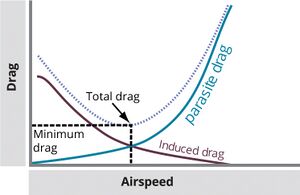Glide Extension: Difference between revisions
Jump to navigation
Jump to search
m 1 revision imported |
No edit summary |
||
| Line 1: | Line 1: | ||
'''Glide Extension''' | |||
[[File:The-total-drag-curve-is-the-source-of-best-glide-speed-diagram.jpg|thumb|right|Glide Science]] | |||
Glide extension refers to techniques pilots use to increase the distance an aircraft can glide after engine failure. These techniques are critical for maximizing reach to a safe landing location. | |||
== Best Glide Speed (L/D Max) == | |||
This is the airspeed at which the aircraft can cover the greatest distance for each unit of altitude lost. | |||
* Pilots should be familiar with their aircraft’s best glide speed, typically listed in the Pilot Operating Handbook (POH). | |||
* Maintaining this speed ensures the aircraft glides efficiently and maximizes distance. | |||
== Wind Conditions == | |||
* '''Tailwinds''' increase ground speed, allowing the aircraft to cover more distance in the same time. | |||
* '''Headwinds''' reduce ground speed, decreasing effective glide range. | |||
* Pilots must account for wind direction and speed when planning a glide. | |||
== Other Factors == | |||
* '''Altitude''': Higher altitude at engine failure increases potential glide distance. | |||
* '''Aircraft Design''': Different aircraft have different glide ratios. | |||
* '''Flaps''': Increase drag and reduce glide performance; should be retracted. | |||
* '''Propellers''': Coarse pitch (low RPM) reduces drag in aircraft with constant-speed propellers. | |||
== Glide Ratio == | |||
The glide ratio is the distance an aircraft travels horizontally for every unit of altitude lost. | |||
* Higher glide ratios result in greater glide distance. | |||
* A common estimate: 1.5 nautical miles per 1000 feet of altitude. | |||
== Glide Distance Calculation == | |||
To estimate glide distance: | |||
: '''Glide Distance (NM) = Glide Ratio * Altitude (ft) / 1000''' | |||
* Example: A glide ratio of 1.5 at 5000 feet gives a distance of 7.5 NM. | |||
== Configuration Tips for Glide Extension == | |||
Based on [https://www.flightsafetyaustralia.com/2022/04/theory-and-practice-getting-the-glide-right/ Flight Safety Australia]: | |||
* Maintain proper configuration: gear up, flaps retracted, cowl flaps closed. | |||
* Reduce propeller RPM to decrease drag (if equipped). | |||
* Avoid skidding/slipping turns, maintain coordinated flight. | |||
* Fine-tune speed based on aircraft weight and conditions. | |||
== Practical Advice == | |||
* Visualize your glide range like a ring around the aircraft. | |||
* Practice transitions from best glide speed to landing configuration. | |||
* In some aircraft, leaving the gear up until landing surface is assured is advised. | |||
* Practice "Power-off 180" maneuvers and short-field landings for proficiency. | |||
== References == | |||
* [https://skybrary.aero/articles/glide-performance SKYbrary] | |||
* [https://www.flightsafetyaustralia.com/2022/04/theory-and-practice-getting-the-glide-right/ Flight Safety Australia] | |||
Revision as of 15:59, 27 March 2025
Glide Extension

Glide extension refers to techniques pilots use to increase the distance an aircraft can glide after engine failure. These techniques are critical for maximizing reach to a safe landing location.
Best Glide Speed (L/D Max)
This is the airspeed at which the aircraft can cover the greatest distance for each unit of altitude lost.
- Pilots should be familiar with their aircraft’s best glide speed, typically listed in the Pilot Operating Handbook (POH).
- Maintaining this speed ensures the aircraft glides efficiently and maximizes distance.
Wind Conditions
- Tailwinds increase ground speed, allowing the aircraft to cover more distance in the same time.
- Headwinds reduce ground speed, decreasing effective glide range.
- Pilots must account for wind direction and speed when planning a glide.
Other Factors
- Altitude: Higher altitude at engine failure increases potential glide distance.
- Aircraft Design: Different aircraft have different glide ratios.
- Flaps: Increase drag and reduce glide performance; should be retracted.
- Propellers: Coarse pitch (low RPM) reduces drag in aircraft with constant-speed propellers.
Glide Ratio
The glide ratio is the distance an aircraft travels horizontally for every unit of altitude lost.
- Higher glide ratios result in greater glide distance.
- A common estimate: 1.5 nautical miles per 1000 feet of altitude.
Glide Distance Calculation
To estimate glide distance:
- Glide Distance (NM) = Glide Ratio * Altitude (ft) / 1000
- Example: A glide ratio of 1.5 at 5000 feet gives a distance of 7.5 NM.
Configuration Tips for Glide Extension
Based on Flight Safety Australia:
- Maintain proper configuration: gear up, flaps retracted, cowl flaps closed.
- Reduce propeller RPM to decrease drag (if equipped).
- Avoid skidding/slipping turns, maintain coordinated flight.
- Fine-tune speed based on aircraft weight and conditions.
Practical Advice
- Visualize your glide range like a ring around the aircraft.
- Practice transitions from best glide speed to landing configuration.
- In some aircraft, leaving the gear up until landing surface is assured is advised.
- Practice "Power-off 180" maneuvers and short-field landings for proficiency.
References